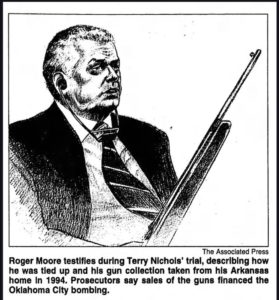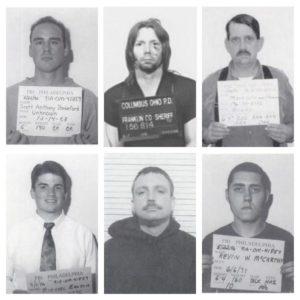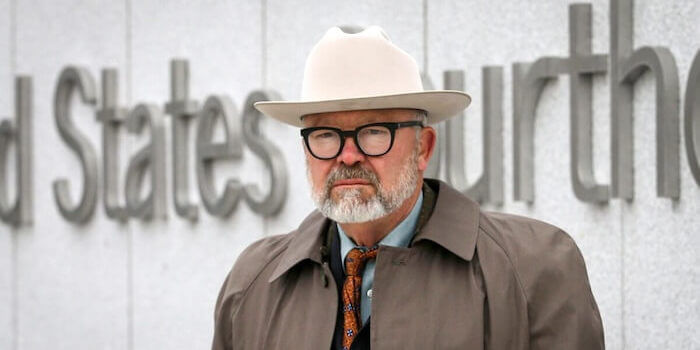(Ken Silva, Headline USA) Utah attorney Jesse Trentadue sued the FBI on Friday for records about a CIA asset who helped fund the Oklahoma City bombing, as well as for records about a neo-Nazi bank-robbery gang also involved in the attack—the deadliest domestic terrorism event in U.S. history.
Trentadue has been suing the U.S. government for OKC bomb-related records for nearly 30 years, ever since his brother was murdered in a federal penitentiary. The complex story of how the death of Trentadue’s brother relates to the OKC bombing can be read in this Mother Jones article.
Trentadue’s latest lawsuit comes nearly a decade after he filed Freedom of Information Act requests for records on the CIA asset, Roger Moore (not the James Bond actor), and the bank-robbery gang, the Aryan Republican Army.
“It has now been 8-1/2 years since Plaintiff submitted his FOIA Request to the FBI and he has not received a single document,” he said in his lawsuit.
According to Trentadue, the FBI could be hiding one of the biggest scandals in its history.
Indeed, the FBI’s interest in withholding records about Moore, who is now dead, could be because he was an FBI informant and CIA asset.
Roger Moore and the CIA
According to Trentadue’s lawsuit, Moore was an FBI informant as part of the bureau’s 1980s- and early 90s-era Operation Punchout, which was designed to identify and apprehend surplus dealers that bought and sold government property stolen from Department of Defense facilities in Utah.

It was in the early 90s when Moore met OKC bomber Timothy McVeigh. The two would become business partners of sorts, embarking on the national gun show circuit in 1993.
In late 1994, McVeigh enlisted his accomplice, Terry Nichols—who helped build McVeigh’s truck bomb but was not in Oklahoma City when the April 19, 1995, attack occurred—to rob Moore.
Motivated by threats to his family, Nichols followed McVeigh’s orders and robbed Moore of some $60,000 in guns, gold bars and other precious metals. Investigators would later determine that the proceeds of this robbery helped fund McVeigh’s terroristic activities.
Moore would serve as a government witness against Nichols, who was convicted and is now serving the rest of his life behind bars at the Florence supermax prison in Colorado. But what wasn’t publicly known at the time was that Moore was a CIA asset.
Indeed, Moore was involved with a paramilitary group called the Civilian Military Assistance, which the CIA used as a proxy to skirt congressional restrictions on supporting the Contras in Nicaragua in the 1980s. Furthermore, Moore build patrol boats for use by the US Navy in the Vietnam War, as well as speedboats for the CIA, according to Aberration in the Heartland of the Real—historian Wendy Painting’s PhD thesis-turned-book about McVeigh.
Moore’s shadowy intelligence connections have had researchers asking for years whether he was actually involved in the bombing, as opposed to being a hapless victim of McVeigh and Nichols’s robbery.
“Moore was also exchanging cryptic messages with McVeigh months later [after the robbery], suggesting that the two men still trusted and confided in each other,” wrote investigator Roger Charles in Oklahoma City: What the Investigation Missed, and Why it Matters.
“Was the Moore robbery intended as a fundraiser for the bombing? Or was the robbery a scam orchestrated by Moore as well as McVeigh, either to defraud the insurance company or to create some plausible distance between them as they plotted an antigovernment revolution?”
Furthering this suspicion is a 2007 sworn declaration from Nichols himself, which Trentadue attached as an exhibit in his Friday lawsuit.
For years, Nichols has directly accused Moore of being a coconspirator in the bombing, which killed 168 people, including 19 children.
At one point, Nichols told the FBI in the mid-2000s that they could find a box of explosives that had been hidden under his home since before he was arrested in 1995. Nichols told FBI investigators that they would find Moore’s fingerprints on those explosives.
“Those explosives components are an important piece of evidence clearly linking Moore to McVeigh and the bombing,” Nichols said in his declaration.
The FBI indeed found the explosives at Nichols’s house, but they didn’t find Moore’s fingerprints. According to investigator Charles, the FBI found fingerprint traces on the box Nichols was talking about, but they did not test them for almost three years—at which point the prints were unreadable.
“I never imagined that once these explosives were seized by the FBI, Moore’s involvement would remain hidden to this day,” Nichols wrote in his sworn declaration.
A more complete history of Moore and his connections to the OKC bombing can be read here.
As for the Aryan Republican Army—the other subject of Trentadue’s newly filed lawsuit—Headline USA has reported extensively on its involvement with OKC.
Aryan Republican Army
Led by Richard Lee Guthrie and a colorful character named Peter Langan—who now goes by the first name Donna, and who recently became the first federal inmate in history to receive a sex change—the ARA was the most prolific gang of bank robbers in the 90s. The neo-Nazis used the proceeds of their robberies to fund groups like the Aryan Nations.
When Guthrie and Langan were arrested for their bank robberies in 1996, observers couldn’t help but wonder if the ARA was somehow linked to the OKC bombing.

After all, the FBI was still hunting for “John Doe 2,” a mysterious accomplice seen by dozens of witnesses with McVeigh on the morning of the attack. Moreover, the Aryan robbers’ mission was to use the proceeds of their heists to fund right-wing terrorist attacks—and someone must have been funding McVeigh, who had been a member of the KKK, as he roamed across America throughout the early ‘90s.
Intrigue about the ARA heightened even further when it was revealed that McVeigh had placed a phone call days before the April 19 attack to Elohim City—a white supremacist compound in the Ozarks that ARA members had used as a hideout.
The link was so obvious that national outlets such as The Washington Post questioned it when covering Langan’s trial.
“One of the enduring mysteries of the Oklahoma City bombing investigation is why, two weeks before the blast, Tim McVeigh placed a 1-minute 46-second phone call to Elohim City. Whom was he calling?” the Post asked in February 1997.
However, the Post failed to pursue that lead, concluding in the same article that “there is no proof that McVeigh knew the Aryan robbers.”
But in the years after the OKC bombing and the 1997 ARA bank-robbery trial, evidence would continue to mount that the two were connected.
In 2001, then-Indiana State University criminologist Mark Hamm published a book making the case that the ARA helped carry out the bombing. Hamm’s In Bad Company: America’s Terrorist Underground detailed the movements of McVeigh and the ARA throughout 1993 and ’94, showing that the bomber was often in Arizona, Kansas and Oklahoma at the same time as Langan, Guthrie and the other ARA members.
“It is highly improbable—if not statistically impossible—for nine men with such violent predispositions and such deep connections within the white power movement … to randomly come together at the same time in the same geographical area,” Hamm concluded, referring to McVeigh, Nichols, Guthrie, Langan and five other Aryan members.
Hamm also identified a plausible reason for why the FBI hasn’t prosecuted ARA members for their role in the OKC bombing: Langan, it turns out, was a Secret Service informant who went rogue. As Hamm noted, revealing that its own informant participated in the attack would have cost many people in the federal government their jobs—at the very least.
Even more shocking, Trentadue later uncovered evidence that the ARA may even have been an FBI front group. Trentadue obtained an email from former FBI agent Don Jarrett—who investigated right-wing terrorism in the 1990s—saying that the Aryan robbers were thoroughly infiltrated by FBI informants.
In his Friday lawsuit, Trentadue expressed his belief that the ARA was indeed an FBI front group.
“Timothy McVeigh participated in some of those robberies and is reported to have used money obtained from these crimes to help fund the bombing of the Murrah Federal Building in Oklahoma City on April 19, 1995. Members of the ARA also assisted McVeigh in carrying out the bombing of the Murrah Federal Building,” he said.
“The ARA was actually a front group created by the FBI in which the Bureau had embedded at least one informant.”
Former FBI agents who investigated the OKC bombing have also linked the ARA to McVeigh. Danny Coulson, who headed the FBI’s hostage rescue team and worked on the OKC case, recently said that McVeigh had, in fact, visited the ARA’s hideout at Elohim City—debunking the Post’s earlier claim that there was “no proof” linking the two. Coulson has publicly called for the case to be reopened.
Other Trentadue Litigation
Meanwhile, Trentadue still has another lawsuit against the FBI for records about the OKC bombing.
That lawsuit, which has been ongoing for decades, seeks surveillance footage of the blast. The FBI has denied that such footage exists, but Trentadue has evidence to the contrary—including a Secret Service investigative memo that describes the surveillance footage.
Trentadue’s lawsuit went to trial in 2014.
There, he was to have FBI informant-turned-whistleblower John Matthews testify on his behalf about how the bureau was monitoring McVeigh in the lead-up to the attack. However, Matthews changed his mind about testifying the night before he was supposed to take the stand, leading to Trentadue alleging that the FBI engaged in witness tampering and threatened Matthews.
Trentadue’s allegations have been subject of a court-appointed investigation for the last nearly eight years. The investigation has been conducted behind closed doors, with gag orders on all parties.
Ken Silva is a staff writer at Headline USA. Follow him at twitter.com/jd_cashless.

